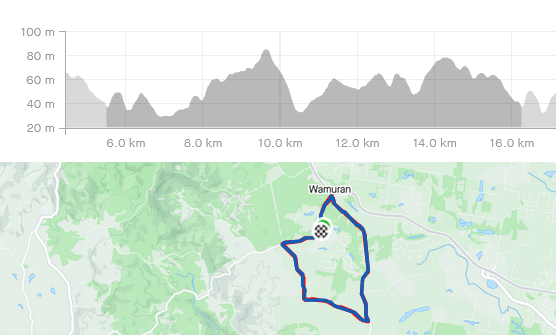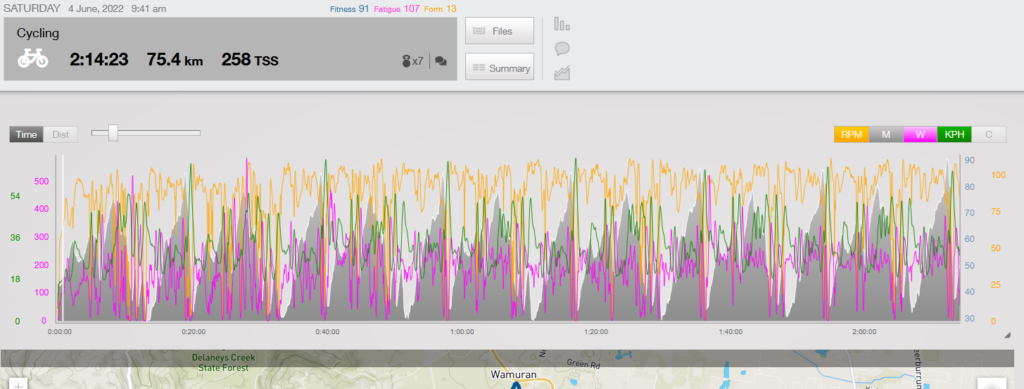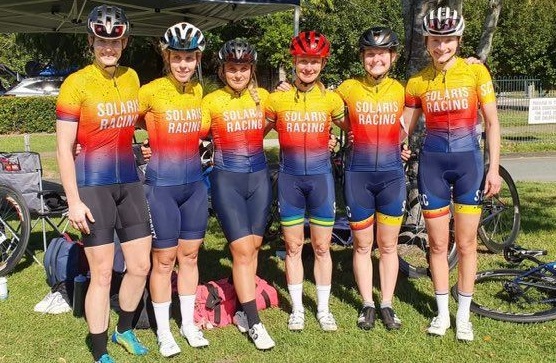Thanks to Ruth Corset for giving me permission to use her data for this cycling power file analysis. Background context, Ruth is 49kg and has an estimated FTP of 248W (5.0W/kg). I say ‘estimated’ as Ruth does not do formal testing, though I do have access to her training data. I might be a few watts out either way, but it is pretty close to this number. If you are familiar with cycling power numbers, you would know this is right up there with the best numbers we see for female riders. Ruth is widely regarded as the best (or close to the best) climber in Australia. We won’t go into the fact that she is 45 years old and still pushing out these incredible numbers!
This data is from a road race in the Queensland Road Team series on June 4 2022. For context, the course was just under 11kms and was lumpy, but with no extended climbs. There was 180m of elevation on the loop with the race being 7 laps. Total elevation was therefore 1200m in a 75km race. The map below shows the elevation profile.

In terms of how the race played out: the peloton stayed together for the first 2 laps. At the end of lap 2 there was a mid-race sprint point. Ruth went for the sprint and then countered off this straight away. Two other riders got away with her for a break of 3. These 3 riders stayed together for the next 3 laps and got a sizeable lead on the chasing peloton (in the range of 2 minutes). At the end of lap 5 there was another sprint point. Ruth attacked at this point, dropping the other 2 riders. She rode the last 2 laps solo gaining 4 minutes on them in the process. I was the DS for her team, but I won’t go into tactics et al. Suffice to say this strategy was planned.
I’ve broken this analysis into three parts – the section before the first attack (laps 1 and 2), the break (laps 3-5) and the solo to victory (laps 6-7). I’ve also provided total ride data. Note, Ruth did not wear a heart rate monitor, so there is power and cadence data only.
For the total ride Ruth rode at a raw power of 185W, normalizing to 215W (4.4W/kg). This gives an intensity factor of 0.87 for the race length of 2 hours and 14 minutes. Average cadence was 93. Let’s look at this broken up in the table below.
|
|
Raw Power |
Normalized Power |
Variability |
Intensity |
Speed |
|
Laps 1-2 |
150W |
197W (4.0W/kg) |
1.31 |
0.79 |
31.9kph |
|
Laps 3-5 |
193W |
216W (4.4W/kg) |
1.12 |
0.87 |
34.1kph |
|
Laps 6-7 |
213W |
230W (4.7W/kg) |
1.08 |
0.93 |
35.0kph |
These numbers offer real insight around the difference in work level when in a breakaway, and when solo. For laps 1-2 the peloton stayed together. There were some attacks, but the intensity between attacks was relatively low. Hence you see the bigger difference between raw and normalized power and the higher variability. It’s a much more polarized power profile, with short hard hits, but longer sections between these. And of course, a lower overall intensity and average speed, despite the fact that Ruth was in a bunch of 25 riders.
For laps 3-5 you can see much less variation between raw and normalized power. This is because the group of 3 were working to establish their break. The raw power was much higher, meaning there was less soft pedaling, with constant pressure on the pedal stroke. The intensity comes up to 0.87 or 4.4W/kg. Considering this was for 65 minutes, it is very solid, reflected in the much higher average speed.
At the end of lap 5, Ruth attacked and soloed off the breakaway group of 3. The last two laps were done at an even higher raw power of 213W. This normalized to 230W which is an Intensity of 0.93 (4.7W/kg) for 35 mins. But remember, this was at the end of the race. She already had significant work in her legs. She increased her average speed to 35kph on these two laps, putting more than 4 minutes into her two breakaway companions. Note the even lower variability. This means there was very little soft pedaling. In other words, she was pushing hard both up and more importantly, downhill.

To finish with, let’s take a look at the attacks and see how much power was required for these breaks and the time course it took. The first attack at the end of lap 2 was the most substantial in terms of length. The one-minute power was 387W which was the highest for the race (7.9W/kg). Then followed 5 minutes pretty much spot on her FTP to establish the break. Hence the reason why coaches will often program ‘hard start’ intervals. That is, you might get something like 30 or 60 seconds hard start, then followed by a few minutes of threshold. This is a good example of why coaches program sessions like this.
The second attack at the end of lap 5 was off the back of the second intermediate sprint. This was a shorter, harder attack. It was 20 seconds at 480W (9.8W/kg). This was a higher 20 second power than for the first attack. From this point on, Ruth pretty much held 230W (4.7W/kg) for the rest of the race (35 mins). In Ruth’s words, go all out and drop them quickly. And that is what she did.
Overall, a super impressive ride from one of the hardest training female cyclists we have in the country. Her reputation for hard training is well known, as is her ‘mongrel’ on the bike. This determination on the bike is matched however with a generous capacity to mentor younger athletes, including her daughters. There are no short cuts to success. Talent to start with, but more importantly, a great work ethic will get you there.

Ruth (red helmet) and her Solaris Racing team mates